 |
Illustration: Mattias Lanas |
An ecologist traces vanishing species right through your neighborhood. Nicholas Weiler wades into the carnage. Illustrated by Mattias Lanas and Andrew McAfee.
Past a gate covered in brambles and down a faint path blocked here and there by fallen trees lies a small pond caked with algae and surrounded by gray willows. By the edge of the pond, Barry Sinervo carefully inserts a cable into the rear of a lifelike pale green gelatin frog. His student, Anna Ringelman, stands by taking notes.
The UC Santa Cruz ecologist has come to study California red-legged frogs. They’re away at the moment, dispersed across campus for the winter. But that doesn’t bother Sinervo. He designed these rubbery agar models, which soak up water and the sun’s warmth just like real amphibians, to test why frogs across California are going extinct. They can stand in for absentee frogs as well as they have for vanished ones.
As real tree frogs begin to chirp in the undergrowth, Sinervo stoops and places the model frog in a juicy spot by the base of a tree. An electronic attachment will monitor its moisture and temperature. “That's a great spot. If I were a frog I'd go in there,” he tells Ringelman. “Just start thinking like a frog, and that’s the experiment.”
Red-legged frogs were common across the state in the 19th century. But hungry gold miners, invasive bullfrogs, urban development and poisonous pesticides have driven them from 70% of their range. Now the federally threatened amphibians hold on in scattered pockets—like this small reservoir in UCSC’s Arboretum. By testing what keeps the frogs comfortable in this holdout, Sinervo and Ringelman hope to learn how to preserve their remaining refuges.
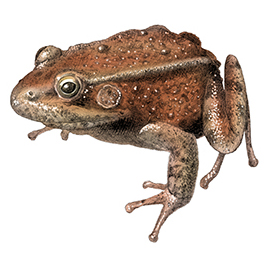 |
| Illustration: Mattias Lanas |
California red-legged frog. |
|
For Sinervo, the red-legged frog is part of a larger forensic effort to understand how California’s changing climate threatens the state’s ecosystems. Some impacts are clear: Mountain lizards retreat to higher ground, frogs succumb to infection, and forests lose ground to fire and scrubland. Species that run out of space will vanish—part of a mass extinction some scientists believe is already under way. “Darwin used to think about the problem of extinctions as being this incredibly remote process,” Sinervo says. “And yet now we can see it in the blink of an eye.”
Sinervo studies dying species like a detective at a murder scene. Comparing the fates of living and vanished populations, he constructs equations to deduce where intertwining pressures may soon push more animals to the brink. Sinervo hopes his equations can help pull threatened species back from the edge and persuade society to prevent the worst effects of climate change before it’s too late. He doesn’t have to go far to study extinction these days. For many species, like the red-legged frogs, its bleeding edge passes through our own back yards.
|
Graphic: Nicholas Weiler |
| The once-broad range of the threatened California red-legged frog has shrunk dramatically since the 19th century from urban development, agricultural toxins, invasive species, and perhaps the changing climate. Ecologists estimate the historic range of the species from prior reports and museum specimens. The maximum current range is based on recent observations, and may include areas where the frogs are extremely rare. "Critical Habitats" are the best known modern sites for the frogs. These locations are protected under the U.S. Endangered Species Act. |
|
Lizards in the lurch
Extinction is a normal part of evolution, says UC Berkeley paleobiologist Tony Barnosky. Usually it’s quite slow. Today, the rate of extinctions is faster than it has been since 65 million years ago, when an asteroid wiped out the dinosaurs and much of life on Earth. The planet has seen five such catastrophic mass extinctions, and many researchers warn we’re heading for a sixth. “It's a frightening realization,” Barnosky says. “Within three or four more human generations, we could lose three out of every four species you're familiar with.”
Sinervo, a lizard ecologist by training, hadn’t thought much about extinctions until he spent a summer surveying European common lizards in the south of France in 2003. That August, a deadly heat wave swept Europe, killing more than 30,000 people. As temperatures climbed past 100°F in Paris, Sinervo knew how to adapt. He walked the cobbled streets wearing shorts and spraying his 4-month-old son with water. He was shocked to see elderly Frenchmen wearing wool suits and berets.
His mind flashed back to the lizards. When the day gets too hot, cold-blooded animals must hide in cool burrows or under rocks. The brutal heat would have kept lizards in hiding—and away from food and mates—for most of the day. If the French lizards hadn’t adapted, Sinervo realized he would see big changes. For the next three summers, he visited sites where his colleagues had studied lizards for decades. He found desolation.
As the climate warms, each new heat wave or drought may kill off some lizards or decrease the number of successful births. Over many years, these small effects add up to push animal societies past a tipping point where they can no longer sustain their numbers. Locally, they go extinct. For the French lizards, these tipping points were so clearly related to local heat waves that Sinervo thought he could predict when and where they would occur, even halfway across the world.
From 2007 to 2009, Sinervo gathered colleagues in Mexico to check old lizard study sites for new extinctions. The distinguished scientists returned to places they had known from their graduate school days, now towing students of their own. Where lizards had once been abundant, the researchers now found site after site abandoned. The professors would sit around at lunch and tally vanished groups of lizards like old friends lost at war. Mexican herpetologist Fausto Méndez-de-la-Cruz told Sinervo the loss was like being punched in the gut.
Sinervo calculated a simple relationship between local temperature spikes since 1975 and the vanished populations. Wherever temperatures had at some point climbed high enough to force lizards to seek refuge for more than four hours a day during the months when they should have been mating, that population was probably now extinct.
Extending the math to more than a thousand lizard research sites across the globe, Sinervo estimated that warming summers in recent decades had probably wiped out 4% of the lizards that had once called these sites home. Colleagues across South America, Europe, Australia and Africa confirmed those losses.
Sinervo’s model predicts that continued warming and more frequent heat waves will soon wipe entire lizard species off the map. By 2050, warming will have sealed the fate of 6% of these species, he estimates. Climate projections for 2080 suggest 20% are likely to disappear forever. Many of the worst affected lizards belonged to isolated species found only on cool mountain slopes. As temperatures increase, these species move higher. Soon they will run out of room.
Carnage in our back yard
“Ready. . . set. . . go!”
Sinervo lifts up a plywood board and UCSC sophomore Elliot Shoenig pounces. He scrabbles in the dirt, then comes away proudly holding a writhing garter snake in one hand and an alligator lizard in the other. The lizard wraps its long tail around Shoenig’s hand, glares sidelong with one yellow eye and bares its tiny teeth.
|
Podcast produced by Nicholas Weiler. Click on image to play. |
Every weekend, Shoenig comes here to Año Nuevo State Park, 20 miles north of Santa Cruz, to count alligator lizards. He tramps through coyote brush and poison hemlock and peers under boards laid down to attract the shy reptiles. Near the parking lot he finds only yellow-eyed southern alligator lizards. In a meadow a mile or so north, he finds only brown-eyed San Francisco (also called northern) alligator lizards. Somewhere in between, Sinervo believes, the yellow-eyed lizards are wiping out their brown-eyed cousins. It’s the front line of a local extinction.
In the five years since publishing his global predictions for lizards, Sinervo has focused on extinctions in California. What he finds can be hard to take. For instance, Sinervo recently brought his family to Death Valley to visit the side-blotched lizards he had studied as a graduate student in the 1980s. They found his old study site, but the lizards that adorn his gold wedding band had vanished for good.
The extinctions were everywhere. “You run the numbers and it turns out you predict extinctions literally in my back yard in Aptos,” he says. Specifically, the model predicted trouble for the San Francisco alligator lizard, which had once been common throughout Santa Cruz County. Sinervo had long been fascinated by the lizard, which gives birth to live young rather than laying eggs. When he saw the prediction, Sinervo called his wife, who checked under the deck of their house. There was an alligator lizard all right, but it was a southern alligator lizard—a yellow-eyed egg-layer. Sinervo has since discovered that southern alligator lizards have taken over on campus, up into the Santa Cruz Mountains, and all the way to Año Nuevo.
San Francisco alligator lizards evolved pregnancy as a way to keep their offspring warm during foggy Northern California summers, but Sinervo suspects this trick has now become a liability. Each summer heat wave risks wiping out a whole generation. In contrast, southern alligator lizards have already laid one clutch of eggs by June and may produce another before the summer is out. They’re winning, and their northward march continues.
Sinervo believes heat and drought have forced the San Francisco alligator lizard to retreat. But the lizard’s decline also matches a broader environmental shift to a landscape where the southern alligator lizard is better adapted to survive. As summers become warmer and drier, typical Northern California woodlands may give way to a scrub and chaparral landscape more common to Southern California, says Todd Dawson, a UC Berkeley biologist who studies redwood forests. It’s no longer enough to study species in isolation, Sinervo says: “We’re seeing whole ecosystem-level responses, and that’s scary.”
The fate of frogs
Sinervo estimates frogs have seen an order of magnitude more local extinctions in California than lizards, but their fates are much harder to predict. They face threats including drought, loss of habitat, pesticides, and disease. “All these things are combined,” says amphibian biologist David Wake of UC Berkeley. “It’s a grim scene.”
|
Photos: Nicholas Weiler |
| Click on the slideshow to see images from the research of Barry Sinervo's team on the UCSC campus and at Año Nuevo State Park. |
“Amphibians are an incredibly tough group of vertebrates. They’ve been around through the past four mass extinctions,” says Vance Vredenburg, a biologist at San Francisco State University. But, he says, “Their extinction rate today is 40,000 times higher than it has been in the last 360 million years.”
One of the biggest threats faced by frogs is death by fungus. Amphibians have battled this foe since their ancestors first crawled out of the sea, but since the 1970s a pandemic of chytrid fungus has been wiping out frog species by the hundreds. This fungus has been around for at least a century, according to analysis of amphibian specimens preserved in museums, and it’s not clear what sparked the plague. Has global trade spread a virulent strain around the world? Have amphibian immune systems become more vulnerable, stressed by heat, pesticides, or habitat loss?
Jason Rohr, a biologist at the University of Florida, suspects the changing climate gives the fungus an advantage in its age-old battle with amphibians. Fungi can adjust to temperature swings much faster than their amphibian hosts, which may let the fungi outmaneuver the immune systems of frogs.
Sinervo and Rohr are collaborating to study how climate, disease, and other forces conspire to threaten California’s frogs. There are too many factors to predict how climate change will affect one species of frogs in isolation, Sinervo says. But by studying the interplay of threats faced by dozens of species across the state, he believes a clearer pattern will emerge.
He has been deploying his gelatin frog models to examine the conditions that long-vanished frogs in the Sierra Nevada and the Central Valley would now be experiencing. He’s also looking for clues in the state’s long-term climate record. “We have all the data here in California,” he says. “Now we're essentially doing all the forensic work.”
Computation for conservation
In December 2014, the University of California awarded $1.9 million to Sinervo and fellow UCSC ecologist Laurel Fox to set up a new institute that will track how climate change affects ecosystems across California. The university’s 39 natural reserves—756,000 acres of protected land—stretch from the state’s high meadows to its desert valleys, from its coastal wetlands to its redwood forests. With colleagues from across the University of California, Sinervo is now extending his extinction models to study the connected fates of California’s amphibians, birds, mammals and plant life.
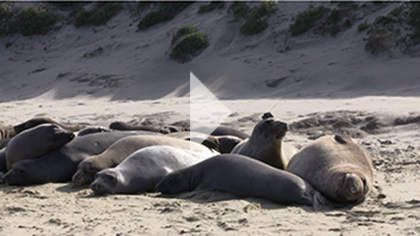 |
Video: Nicholas Weiler |
| UC Santa Cruz ecologist Barry Sinervo describes a statewide project to track the effects of climate change across the UC Natural Reserve System. Click on image to go to Vimeo page. |
|
Sinervo hopes to use his models to demonstrate more clearly than ever before how climate change is driving species to extinction. Then he plans to sue for federal action under the Endangered Species Act. If his equations can show that climate change is the main force driving species to the brink, Sinervo says, “the only way to protect them is to actually limit carbon [emissions].” But first, he says, “we have to hit a critical hurdle of evidence.”
This approach is controversial. In 2008 the polar bear became the first animal listed as threatened because of climate change. However, both the Bush and Obama administrations have insisted that the Endangered Species Act cannot be used to regulate emissions. The major legal obstacle is how to pin responsibility for climate change to the actions of specific polluters, says Vanderbilt University legal scholar J.B. Ruhl. More evidence connecting global warming to extinctions is not likely to change the situation, Ruhl says bluntly: “Everyone already assumes that.”
This criticism does not stifle Sinervo’s passion. Even if plans to force federal action don’t succeed, he says, his extinction models can sharpen existing conservation efforts. The old notion of preserving animals’ historical habitats may become “an absurd proposition,” he says. Instead, conservationists will need to plan safe havens for threatened species—places where they might survive in the climate of the future.
Sinervo also hopes his work will bring the impacts of climate change home to Californians. The extinction crisis is not happening elsewhere, he says. It exists in our yards, our forests, our mountains—and in our small campus ponds.
This pond, these frogs
The small reservoir pond at UCSC’s Arboretum used to be an ideal breeding site for red-legged frogs. It’s just the right size, it has plenty of algae for tadpoles to eat, and the campus provides the hilly woodlands the frogs like. But in recent years the surrounding willows have grown close, shutting out the sun. Frogs need the sun to warm them before they become active enough to eat and mate and lay their eggs, but too much sun can dry them out. Arboretum caretakers wanted to trim the trees back, but they didn’t want to go too far and fry the frogs. That’s when they brought in Sinervo and Ringelman.
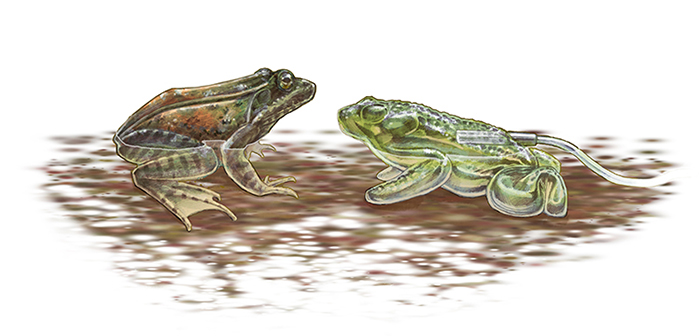 |
| Illustration: Andrew McAfee |
“How much willow is too much?” Sinervo asks. “We don’t know.” As winter turns to spring, Ringelman will track the model frogs’ temperature and moisture in sun and shade around the pond. Soon caretakers will trim the willows back in sections, and she will study whether this improves the habitat. For Sinervo, the data she collects will provide one more clue in the big picture of frog extinctions across the state. But for Ringelman, it’s very much about this pond and these frogs.
Ringelman stoops and places another frog model under a log by the edge of the reservoir. The UCSC senior grew up in the Santa Cruz Mountains. She has spent the last three years hiking through poison oak and kayaking through San Francisco Bay marshland to study threatened species. “I didn’t realize until this year that we had red-legged frogs on campus,” she says. Now she’s quite fond of them. As spring approaches and frogs return to the pond, Ringelman has been visiting in the evenings to count their glittering eyes.
She points out giant strings of translucent tapioca-like salamander eggs floating at the pond’s edge. “How cool is it that you can come down here and see all this?” she says. She wonders how many eggs will dry out as the waterline recedes, and whether kindly pushing them down into the pond would result in an unnatural explosion of salamanders next year. The balance between helping and harming is a fragile one.
For a moment, the big questions of how global warming will transform this habitat and how to save the species recede into the background. Right now it’s enough for Ringelman to focus on thinking like a frog.
© 2015 Nicholas Weiler / UC Santa Cruz Science Communication Program
Top
Biographies
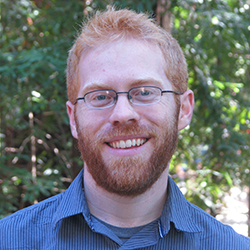
Nicholas Weiler
B.A. (neurobiology and behavior) Columbia University
Ph.D. (neurosciences) Stanford University
Internship: UC San Francisco news office
Having grown up a bookish kid with a love of words, history and drama, I surprised my family by studying neuroscience. To me, it made sense. Language, art, civilization—all arise from this web of tangled neurons, puffing away in their tantalizing chemical language.
In graduate school I studied learning. How do experiences engrave themselves into the brain’s shifting patterns of connectivity? Eventually my own brain learned that I enjoyed telling the stories of science more than creating them myself. I became the nerve center for a network of neurobloggers and podcasters, carving the message home.
Now that I’ve traded pipette and microscope for notebook and microphone, I can record the drama of discovery and probe the space between human and nature. I've returned to the love of words and stories that enriched my childhood.
Nicholas Weiler's website
. . . . . . . . . . . . . . . . . . . . . . . . . . . . . . . . . . . . . . . . . . . . . . . . . . .
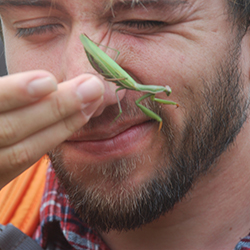
Mattias Lanas
B.S. & M.S. (Earth systems) Stanford University
Internship: Hopkins Marine Station, Pacific Grove, CA
Mattias has been passionate about art and the natural world since he was little, having grown up among the mountains and coasts of Chile. His interest in plants and animals only increased with his transition to high school in the USA, where he spent his leisurely time playing with his family dog, growing garden vegetables, and attempting to rear tropical vines from seed. After graduating with two degrees from Stanford University, Mattias spent a couple of years as an educator in Maine, teaching art and natural history at a environmentally-focused semester school. He now hopes to merge his science, education and art backgrounds to pursue conservation work, helping prevent the destruction of natural ecosystems through awareness and appreciation of the world's flora and fauna.
Mattias Lanas's website
. . . . . . . . . . . . . . . . . . . . . . . . . . . . . . . . . . . . . . . . . . . . . . . . . . .
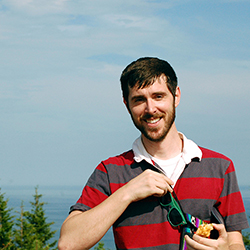
Andrew McAfee
B.S. (biology) Mary Washington College, Fredericksburg, VA
Andrew McAfee is a scientific illustrator from central Virginia. He likes swamps, snakes, Excel formulas, and understatements. In college, Andrew discovered an affinity for ornithology, ichthyology, and digital art. Thanks to the program at CSUMB, he fosters a keen new interest in scientific animation as well as illustration.
Andrew McAfee's website
Top |

